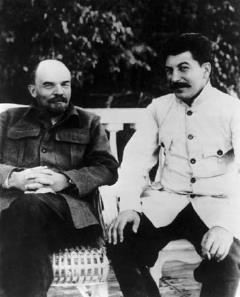Government and PoliticsIron Curtain |
How many leaders did the Soviet Union have? |
From its formation in 1922 (just five years after tsarist Russia had fallen in the revolution of 1917), the Union of Soviet Socialist Republics (U.S.S.R.) had only 10 leaders. But just five of these had meaningful tenure, either due to length of time served or true authority: Lenin, Stalin, Khrushchev, Brezhnev, and Gorbachev.
After tsarist Russia ended with the revolution of 1917, Bolshevik leader Vladimir Lenin (1870–1924) became head of the Soviet Russian government as chairman of the Council of People’s Commissars (the Communists), dissolving the elected assembly and establishing a dictatorship. This lasted six years: When Lenin died of a stroke in 1924, Joseph Stalin (1879–1953)—who had been an associate of Lenin—promptly eliminated his opposition and in 1929 established himself as a virtual dictator. Stalin ruled the U.S.S.R. during World War II (1939–45), and though he was aligned with the United States, Britain, and the other Allied nations during that conflict, soon after the war, he began a buildup of power in Eastern Europe, leading to the Cold War (1947–89). Even though Stalin’s domestic policies were extremely repressive and he ruled largely by terror, he remained in power until his death in 1953.
After Stalin died, the Soviet Union entered a brief period of struggle among its top leaders: Deputy Premier Georgy Malenkov (1902–1988), a longtime Stalin aide, came to power. In 1955 Malenkov was forced to resign, and he was succeeded by his (and Stalin’s) former defense secretary, Nikolai Bulganin (1895–1975). However, Bulganin was a premier in name only; the true power rested with Communist Party secretary Nikita Khrushchev (1894–1971), who expelled Bulganin and officially took power as premier in 1958.
Khrushchev denounced the oppression of the long Stalin years, which had ended only five years earlier, and worked to improve living standards. On the international front, he pursued a policy of “peaceful coexistence” with the West and even toured the United States in 1959, meeting with President Dwight D. Eisenhower (1890–1969). In 1960 a U.S. reconnaissance plane was shot down over the U.S.S.R., raising doubts among the Soviets about Khrushchev’s policy toward the West. Further troubles at home resulted from widespread hunger due to crop failures. Meantime, Khrushchev advanced the cause of Soviet space exploration, beginning the so-called space race with the United States. Eventually, his stance on international issues, which included a rift with Communist China, led to his downfall. He was removed from power in October 1964.
Khrushchev’s ouster (which was a forced retirement) had been engineered by his former ally and political adviser Leonid Brezhnev (1906–1982). With Khrushchev out of the way, technically Brezhnev was to lead the country along with premier Alexei Kosygin (1904–1981). But as head of the Communist Party, it was Brezhnev who truly held the power. By the early 1970s, Brezhnev emerged as the Soviet chief—even though Kosygin remained in office until 1980. During his administration, Brezhnev kept tight control over the Eastern bloc (Communist countries), built up the Soviet Union’s military (in what became an arms race with the United States), and did nothing to try to reverse the downward trend of the Soviet Union’s economy.
When Brezhnev died in 1982, he was succeeded by Yuri Andropov (1914–1984). However, Andropov died two years later and Konstantin Chernenko (1911–1985) replaced him as premier. When Chernenko, too, died an untimely death in March 1985, Mikhail S. Gorbachev (1931-) became head of the Communist Party and leader of the Soviet Union. With Gorbachev, the reign of the old guard of Stalin-trained leaders had come to an end. Gorbachev’s policies of openness to the West and economic development led to the disintegration of the Soviet Union, with Communist rule ending in 1991 and each Soviet republic setting up its own government.

